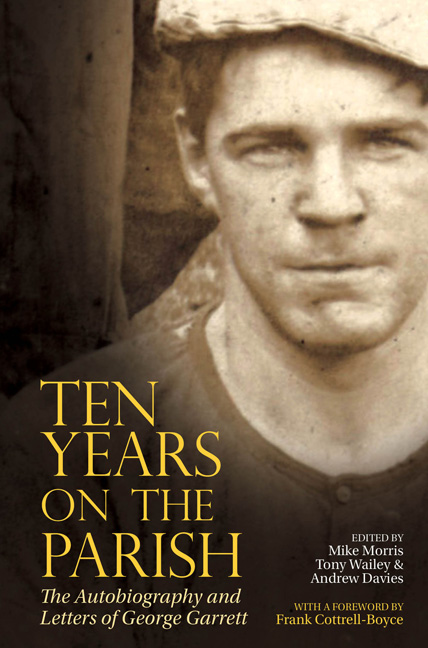Book contents
- Frontmatter
- Contents
- List of Illustrations
- Acknowledgements
- Foreword
- Frontispiece
- Introduction to Ten Years On The Parish
- Notes on the Text
- Autobiography from Ten Years On The Parish
- Ten Years On The Parish
- Dear Garrett: An introduction to the Garrett–Lehmann Letters
- Letters between George Garrett and John Lehmann
- Additional information
- Index
- Miscellaneous Frontmatter
Foreword
- Frontmatter
- Contents
- List of Illustrations
- Acknowledgements
- Foreword
- Frontispiece
- Introduction to Ten Years On The Parish
- Notes on the Text
- Autobiography from Ten Years On The Parish
- Ten Years On The Parish
- Dear Garrett: An introduction to the Garrett–Lehmann Letters
- Letters between George Garrett and John Lehmann
- Additional information
- Index
- Miscellaneous Frontmatter
Summary
Why should you read this book?
I first read George Garrett because my dad told me to.
My dad's dad was a stoker – just as Garrett had been. He died at sea when my father was in his teens, so when my dad read The ‘Maurie’ – Garrett's account of working in the engine room of that great Scouse ship the Mauretania – he was listening for some echo of his lost father's voice, hoping to glimpse the sweat and fire of his engine room. Garrett's writing allowed him to wander again the streets of ‘Sailortown’ – the patchwork of hectic dockside streets between Scotland Road and the docks where he had grown up. A vanished realm, comfortingly parochial but thrillingly connected to the rest of the world. I was born there and can just about remember the brilliant, improbable fauna of the tenement balconies – the monkeys and parrots brought back by sailors from far horizons – as presents for their wives, who barely ever left their native parishes.
To hear and feel the world as it was, is a decent reason to read a book.
It's why my dad read this book.
But it's not why you should read it.
It wasn't easy being a Garrett fan. The man had more pseudonyms than the Irish writer Brian O'Nolan / Flann O'Brien / Myles na gCopaleen. Until Michael Murphy brought out the Collected Writings in 1999, you had to be a bit of a detective. Dad chased down leads and found fragile scraps in the local history archive. I remember how thrilled he was when he spotted the famous mention of Garrett in The Road to Wigan Pier, which came with the useful information that Garrett had written under the name of Matt Low (as in Matelot – sailor). He gave a talk at the Liverpool Writing on the Wall festival in which he shared his enthusiasm and discoveries. Garrett's family came to listen and that was one of the steps on the road that lead to the publication of this book. He later helped catalogue the archive of material as part of the George Garrett Archive Project. But for the enthusiasm of his readers, Garrett's writings would be lost.
- Type
- Chapter
- Information
- Ten Years on the ParishThe Autobiography and Letters of George Garrett, pp. xi - xiiiPublisher: Liverpool University PressPrint publication year: 2017

